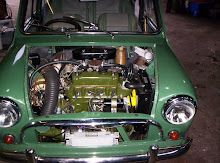Most service stations can check the compression of each cylinder with the aid of a special pressure gauge. A gauge is not a very expensive item, and is always useful to have if you like to carry out periodical checks on the efficiency of your engine, as it quickly shows up faults such as burnt or sticking valves. With the engine at its normal working temperature, all sparking plugs are removed and the gauge inserted in each sparking-plug hole in turn, while the engine is rotated by the starter motor, with the throttle held wide open, until the highest reading is obtained.
The compression should be equal on all cylinders. If the compression is weak on one or more cylinders the most likely cause is burnt or pitted valve faces. Leakage of gases past the piston rings cannot, of course, be discounted, but this fault will normally be accompanied by excessive oil consumption.
Apart from the compression test, a reliable indication of the general condition of the engine can be obtained by the use of a manifold vacuum gauge of the type that is included, for example, in the Redex Do-it-yourself Tuning Kit, following the detailed instructions for engine testing that are supplied with the particular kit. A practical owner will quickly find such a gauge invaluable, not only in diagnosing such faults as burnt or sticking valves, worn piston rings and defective sparking plugs but also in carrying out carburettor and ignition timing adjustments.
Saturday, 17 October 2009
Engine Tests
Posted by Info Mini Cars at 02:04
Subscribe to:
Post Comments (Atom)


0 comments:
Post a Comment